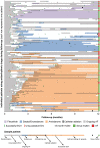Antiarrhythmic drugs in patients with early persistent atrial fibrillation and heart failure: results of the RACE 3 study
- PMID: 33899093
- PMCID: PMC8427339
- DOI: 10.1093/europace/euab062
Antiarrhythmic drugs in patients with early persistent atrial fibrillation and heart failure: results of the RACE 3 study
Abstract
Aims: Maintaining sinus rhythm in patients with persistent atrial fibrillation (AF) is challenging. We explored the efficacy of class I and III antiarrhythmic drugs (AADs) in patients with persistent AF and mild to moderate heart failure (HF).
Methods and results: In the RACE 3 trial, patients with early persistent symptomatic AF and short history of mild to moderate HF with preserved or reduced left ventricular ejection fraction (LVEF) were randomized to targeted or conventional therapy. Both groups received AF and HF guideline-driven treatment. Additionally, the targeted-group received mineralocorticoid receptor antagonists, statins, angiotensin-converting enzyme inhibitors and/or receptor blockers, and cardiac rehabilitation. Class I and III AADs could be instituted in case of symptomatic recurrent AF. Eventually, pulmonary vein isolation could be performed. Primary endpoint was sinus rhythm on 7-day Holter after 1-year. Included were 245 patients, age 65 ± 9 years, 193 (79%) men, AF history was 3 (2-6) months, HF history 2 (1-4) months, 72 (29.4%) had HF with reduced LVEF. After baseline electrical cardioversion (ECV), 190 (77.6%) had AF recurrences; 108 (56.8%) received class I/III AADs; 19 (17.6%) flecainide, 36 (33.3%) sotalol, 3 (2.8%) dronedarone, 50 (46.3%) amiodarone. At 1-year 73 of 108 (68.0%) patients were in sinus rhythm, 44 (40.7%) without new AF recurrences. Maintenance of sinus rhythm was significantly better with amiodarone [n = 29/50 (58%)] compared with flecainide [n = 6/19 (32%)] and sotalol/dronedarone [n = 9/39 (23%)], P = 0.0064. Adverse events occurred in 27 (25.0%) patients, were all minor and reversible.
Conclusion: In stable HF patients with early persistent AF, AAD treatment was effective in nearly half of patients, with no serious adverse effects reported.
Keywords: Antiarrhythmic drugs; Atrial fibrillation; Early persistent atrial fibrillation; Heart failure; Rhythm control.
© The Author(s) 2021. Published by Oxford University Press on behalf of the European Society of Cardiology.
Figures



Similar articles
-
Old and new antiarrhythmic drugs for converting and maintaining sinus rhythm in atrial fibrillation: comparative efficacy and results of trials.Am J Cardiol. 2003 Mar 20;91(6A):15D-26D. doi: 10.1016/s0002-9149(02)03375-1. Am J Cardiol. 2003. PMID: 12670638 Review.
-
Long-term outcome of targeted therapy of underlying conditions in patients with early persistent atrial fibrillation and heart failure: data of the RACE 3 trial.Europace. 2022 Jul 15;24(6):910-920. doi: 10.1093/europace/euab270. Europace. 2022. PMID: 34791160 Free PMC article. Clinical Trial.
-
Dronedarone for the treatment of atrial fibrillation with concomitant heart failure with preserved and mildly reduced ejection fraction: a post-hoc analysis of the ATHENA trial.Eur J Heart Fail. 2022 Jun;24(6):1094-1101. doi: 10.1002/ejhf.2487. Epub 2022 Apr 10. Eur J Heart Fail. 2022. PMID: 35293087 Free PMC article.
-
[Combined Approach for Management of the Chronic Heart Failure with Preserved Left Ventricular Ejection Fraction and Permanent Atrial Fibrillation: a Case Report].Kardiologiia. 2020 Mar 30;60(4):157-160. doi: 10.18087/cardio.2020.4.n1096. Kardiologiia. 2020. PMID: 32394871 Russian.
-
Antiarrhythmics for maintaining sinus rhythm after cardioversion of atrial fibrillation.Cochrane Database Syst Rev. 2019 Sep 4;9(9):CD005049. doi: 10.1002/14651858.CD005049.pub5. Cochrane Database Syst Rev. 2019. PMID: 31483500 Free PMC article.
Cited by
-
[Catheter ablation in patients with heart failure-who benefits?].Herzschrittmacherther Elektrophysiol. 2025 Mar;36(1):3-9. doi: 10.1007/s00399-025-01066-w. Epub 2025 Jan 30. Herzschrittmacherther Elektrophysiol. 2025. PMID: 39883128 Review. German.
-
Real-world utilization of the pill-in-the-pocket method for terminating episodes of atrial fibrillation: data from the multinational Antiarrhythmic Interventions for Managing Atrial Fibrillation (AIM-AF) survey.Europace. 2023 Jun 2;25(6):euad162. doi: 10.1093/europace/euad162. Europace. 2023. PMID: 37354453 Free PMC article.
-
Atrial Fibrillation can adversely impact Heart Failure with Preserved Ejection Fraction by its association with Heart Failure Progression and Mortality: A Post-Hoc Propensity Score-Matched Analysis of the TOPCAT Americas Trial.Europace. 2023 May 19;25(5):euad095. doi: 10.1093/europace/euad095. Europace. 2023. PMID: 37078691 Free PMC article.
-
Early Rhythm Control Therapy in Patients With Atrial Fibrillation and Heart Failure.Circulation. 2021 Sep 14;144(11):845-858. doi: 10.1161/CIRCULATIONAHA.121.056323. Epub 2021 Jul 30. Circulation. 2021. PMID: 34328366 Free PMC article.
-
Practical compendium of antiarrhythmic drugs: a clinical consensus statement of the European Heart Rhythm Association of the European Society of Cardiology.Europace. 2025 Aug 4;27(8):euaf076. doi: 10.1093/europace/euaf076. Europace. 2025. PMID: 40159403 Free PMC article. Review.
References
-
- Anter E, Jessup M, Callans DJ.. Atrial fibrillation and heart failure: treatment considerations for a dual epidemic. Circulation 2009;119:2516–25. - PubMed
-
- Marrouche NF, Brachmann J, Andresen D, Siebels J, Boersma L, Jordaens L, CASTLE-AF Investigators et al.Catheter ablation for atrial fibrillation with heart failure. N Engl J Med 2018;378:417–27. - PubMed
-
- HindricksG, , PotparaT, , DagresN, , ArbeloE, , BaxJJ, , Blomstrom-Lundqvist C. et al.ESC Guidelines for the diagnosis and management of atrial fibrillation developed in collaboration with the European Association for Cardio-Thoracic Surgery (EACTS). Eur Heart J 2021;42:373–498. - PubMed
-
- Rienstra M, Hobbelt AH, Alings M, Tijssen JGP, Smit MD, Brugemann J, for the RACE 3 Investigators et al.Targeted therapy of underlying conditions improves sinus rhythm maintenance in patients with persistent atrial fibrillation: results of the RACE 3 trial. Eur Heart J 2018;39:2987–96. - PubMed
-
- De With RR, Rienstra M, Smit MD, Weijs B, Zwartkruis VW, Hobbelt AH. et al.Targeted therapy of underlying conditions improves quality of life in patients with persistent atrial fibrillation: results of the RACE 3 study. Europace 2019;21:563–71. - PubMed
Publication types
MeSH terms
Substances
LinkOut - more resources
Full Text Sources
Other Literature Sources
Medical
Research Materials
Miscellaneous

